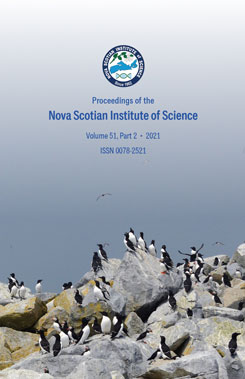The distribution and life history of Mysis gaspensis O.S. Tattersall, 1954 (Crustacea, Mysida): An almost endemic, nektonic component of Atlantic Canada estuarine and coastal ecosystems
DOI:
https://doi.org/10.15273/pnsis.v51i2.11164Abstract
Mysids (Mysida) or opossum shrimp are nektonic Crustacea found worldwide in freshwater, hypogean, coastal marine or deep-sea habitats. A poorly known, highly localized species Mysis gaspensis O.S. Tattersall, 1954 is found only in Atlantic Canada and Maine, USA. During spring to autumn, localized populations form aggregations at low tide in littoral estuarine environments but individuals also occur at littoral coastal sites. In boreal habitats, this mysid has a univoltine, semelparous life cycle. Beginning in March-April, juveniles are released from the female marsupium at 2.0-2.5 mm total length (TL). Growth in TL is linear (r2 = 0.90), and growth in wet weight is exponential (b = 2.96). Females attain 14.1-16.5 mm TL and males 13.9-25.5 mm TL, by November when they begin maturation.During November-January, penultimate and ultimate males and females migrate seaward where copulation is presumed to occur. Males die after copulation. Development of young during winter results in a mixture of embryo development stages in individual female marsupia by spring. Mean brood size is 59 embryos (range 32-83). Females reoccupy estuarine habitats during March-April and release their young. Females survive after release of young and attain a maximum length of ~20.0 mm TL, but most die or are predated upon by late July. Juveniles and adults of some populations form highly visible aggregations during low tide in the shallow water of estuaries occupying sites with low velocity currents (12-41 cm/s) and near the limit of salinity (0.5-19.0). Aggregations range in size up to 38,000 individuals but the population in some estuaries is often scattered at low tide in small groups or individuals on the down-stream side of rocks or underwater structures.
Keywords: aggregations; brood size; growth; maturation; opossum shrimp; reproduction


